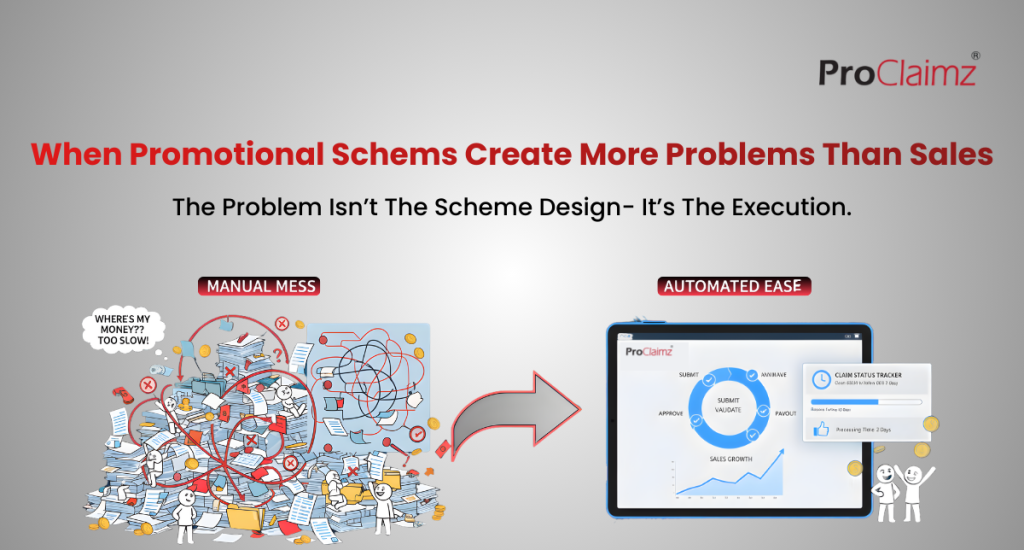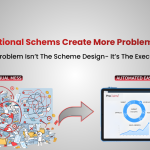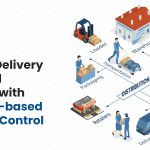Promotional schemes are designed to drive sales. Manufacturers offer additional incentives. Distributors increase their purchases. Sales grow. Everyone benefits.
That’s the theory.
In practice, many promotional schemes create friction instead of momentum. The problem isn’t the scheme design—it’s the execution process. Specifically, the claim settlement process.
Three Recurring Complaints
Distributors participating in promotional schemes consistently raise the same concerns.
“Nobody can tell me where my claim is.”
Claims get submitted. Time passes. Distributors follow up. The response is vague: “It’s being processed.” Days turn into weeks. The distributor calls again. Still processing. The status remains unclear.
This lack of visibility creates uncertainty. Distributors have made inventory investments based on expected scheme benefits. Cash flow planning accounts for anticipated payouts. When claims sit in an undefined status for extended periods, business planning becomes difficult.
The question isn’t always about the timeline. It’s about information. A distributor who knows their claim is in finance review and will be processed by a specific date can plan accordingly. A distributor who knows nothing except “processing” cannot.
“The payout doesn’t match what was expected.”
A distributor believed they qualified for a certain amount. The payment that arrives is different. Sometimes lower. Occasionally higher. Either way, the mismatch creates confusion.
This happens for several reasons. Scheme terms may have conditions that weren’t clearly understood. Certain products might be excluded in ways that weren’t obvious. Other promotional benefits might offset eligibility. Calculation errors might occur in manual processes.
Whatever the cause, unexpected payout amounts damage trust. Even when the company is technically correct, the distributor’s perception matters. Mismatched expectations indicate communication failures somewhere in the process.
“Settlement takes too long.”
This is the most frequent complaint. Schemes are attractive. Participation requirements are met. Claims are submitted promptly. Then the wait begins.
Four weeks. Six weeks. Eight weeks. Sometimes longer. Meanwhile, the distributor’s working capital is tied up in inventory purchased based on expected scheme benefits. Cash flow tightens. The distributor may reduce subsequent orders because capital is already committed to inventory with unrealized returns.
By the time payment arrives, enthusiasm has cooled. The trust has been tested. Willingness to participate aggressively in future schemes has decreased. The scheme succeeded in driving temporary sales but may have weakened the long-term relationship.
Why Manual Processing Creates Delays
Claim settlement delays are usually process problems, not decision problems.
Manual data compilation takes time. A distributor submits invoices and supporting documents via email. Someone must download these. Open each file. Extract relevant data. Enter it into a spreadsheet or system. For claims with multiple line items across various invoices, this is time-consuming.
Validation is sequential, not parallel. The claim goes to one person for initial review. Then to another for verification. Then to a regional manager for approval. Then to finance for processing. Each step waits for the previous one to complete. If anyone in the chain is traveling or busy, the entire process pauses.
Documentation loops add days. The claim reaches finance. Something is missing—perhaps a specific sales report or a secondary document. Finance sends an email requesting it. The request sits in an inbox. Eventually, someone responds. The document gets compiled and sent. More days have passed.
Calculation errors require rework. Manual calculations sometimes have mistakes. Wrong formula applied. Data entry error. Product code misread. The error gets caught during review. The claim goes back for correction. The clock restarts.
Approval bottlenecks create queues. All claims need senior approval. That person has many responsibilities. Claims wait their turn. During month-end or busy periods, the queue gets longer. Processing slows further.
None of this reflects poorly on the people involved. Manual processes are inherently slow when volumes increase. Systems that require human intervention at multiple stages will have delays. This is process architecture, not personal performance.
The Transparency Gap
The second major issue is information visibility—or the lack of it.
Distributors submit claims and then have no way to track progress. They don’t know which stage the claim is in. They don’t know what’s pending. They don’t know when to expect resolution. So they call or email to ask.
This creates work for both sides. The distributor spends time following up. Someone in the company spends time answering status queries. Neither activity adds value. Both are necessary only because the process lacks transparency.
On the company side, management often lacks clear visibility into the claims pipeline. How many claims are pending? Which stage has the longest backlog? What’s the average processing time? Where are bottlenecks occurring?
Without this visibility, process improvement is reactive rather than proactive. Problems are addressed after they become severe, not when they start developing.
Transparency serves both parties. Distributors can plan when they have information. Companies can optimize when they have data. The absence of transparency creates unnecessary friction and inefficiency.
When Complexity Reduces Participation
Scheme design sometimes works against scheme objectives.
Complex eligibility criteria confuse participants. Multiple conditions stacked together become hard to understand. Product inclusion and exclusion lists require careful checking. Minimum purchase thresholds combined with specific product mixes create calculation complexity. Conditions about not combining with other benefits add another layer.
The intention behind complexity is often good. Marketing teams want to drive specific behaviors. Finance teams want to protect margins. Product teams want to push particular SKUs. Each department adds requirements that make sense individually.
The cumulative result can be schemes that are difficult to explain clearly and even harder to calculate accurately in real-time customer conversations.
When distributors don’t fully understand scheme terms, participation becomes cautious. They don’t want to invest heavily only to discover later that they weren’t actually eligible. Conservative participation reduces the scheme’s effectiveness.
When sales teams can’t explain terms clearly, misinformation spreads. Distributors form incorrect expectations. Claims get submitted based on misunderstandings. Payouts don’t match expectations. Disputes increase. Processing takes even longer.
There’s a balance between targeted schemes and simple schemes. Both can be effective. But schemes that are so complex that participants struggle to understand them will underperform regardless of how attractive the benefits are.
What Systematic Scheme Management Looks Like
Companies that handle promotional schemes effectively have moved from manual processes to systematic approaches.
Scheme definition happens in the system, not just in documents. All terms, conditions, eligibility criteria, and calculation logic are configured in the scheme management platform. This eliminates ambiguity about what rules actually apply.
Eligibility is transparent upfront. Distributors can see in advance whether they qualify and what the expected benefit would be. This reduces surprises later. Participation becomes informed rather than speculative.
Claims are submitted through structured processes. Instead of emailing attachments, claims go through a portal with specific fields and required documentation clearly listed. Validation happens at submission. Incomplete claims are flagged immediately, not weeks later.
Calculations are automated. The system applies scheme logic to submitted data and calculates amounts. The calculation breakdown is visible. Both the distributor and the company can see exactly how the amount was determined. Disputes decrease because transparency increases.
Workflows move claims automatically. Once a claim passes initial validation, it routes through approval stages automatically. No one needs to manually forward it. Notifications alert reviewers when action is needed. The process keeps moving without manual pushing.
Status is always visible. Distributors can log in and see exactly where their claim is in the process. Expected timelines are shown. If additional documentation is needed, they’re notified immediately. No need to call and ask for updates.
Timelines become predictable. When the process is systematic, average processing time becomes measurable. The company can commit to timelines with confidence. Distributors can plan based on reliable information. Predictability rebuilds trust.
Audit trails exist automatically. Every action is logged with timestamp and user. Claims history is preserved. If questions arise later, the complete record exists. This protects both parties and simplifies compliance.
ProClaimz Approach
ProClaimz is built specifically to handle promotional scheme and claims management for manufacturers.
Scheme definition in the system ensures all terms and conditions are captured clearly. Eligibility criteria are configured rather than documented. Calculation logic is systematic rather than manual. Changes and updates to schemes are version-controlled.
Distributor-facing portal provides visibility and control. Participants can check their eligibility status. They can submit claims through structured forms. They can track claim status in real-time. They can see calculation breakdowns for transparency.
Automated workflows handle routing and approvals. Claims move through defined stages automatically. Notifications go to appropriate reviewers at each stage. Bottlenecks become visible immediately when claims sit too long in any stage.
Validation happens upfront. The system checks for completeness and accuracy at submission. Data requirements are verified automatically. Calculation errors are eliminated because logic is systematic. Rework loops from missing information or calculation mistakes decrease significantly.
Settlement tracking provides visibility to finance teams. All pending claims are visible in one place. Processing timelines are tracked. Payment status is monitored. Reconciliation is simplified.
Reporting provides insights into scheme performance. Participation rates by distributor. Claim patterns by region. Processing times by stage. This data enables continuous improvement of both schemes and processes.
The goal isn’t to replace judgment with automation. It’s to eliminate administrative friction so that scheme management focuses on strategy and relationships rather than paperwork and status queries.
Measuring What Matters
The effectiveness of promotional schemes shouldn’t be measured only by sales uplift during the scheme period. Longer-term effects matter more.
Participation trends over time indicate distributor confidence. When participation increases scheme after scheme, trust is high. When participation declines despite attractive terms, trust has been damaged—usually by past execution problems.
Claim settlement times measure process efficiency. The gap between claim submission and payment completion should be tracked consistently. Improvements in this metric indicate process optimization. Deterioration indicates growing problems.
Distributor satisfaction can be measured directly. Simple surveys after claim settlement can gauge experience. Net Promoter Score for schemes indicates whether distributors would recommend participating. These metrics reveal relationship impact beyond pure sales numbers.
Scheme ROI should account for administrative costs. If processing claims requires significant manual effort, that cost should be factored into scheme economics. Automation that reduces processing costs improves ROI even before considering relationship benefits.
Repeat participation is the ultimate indicator. Distributors who participate enthusiastically in scheme after scheme are indicating through behavior that the execution matches the promise. Distributors who participate cautiously or skip schemes are signaling problems with past experiences.
Building Trust Through Execution
Promotional schemes are investments in channel relationships. The return on that investment depends heavily on execution, not just scheme design.
Attractive terms with poor execution create disappointment. Average terms with excellent execution build loyalty. The distributor’s experience of the claim process matters as much as the scheme benefits themselves.
Fast settlements build confidence. Transparent calculations build trust. Predictable processes enable planning. These execution elements strengthen relationships in ways that scheme percentages alone cannot achieve.
The manufacturers succeeding with channel promotions aren’t necessarily offering the most generous schemes. They’re offering schemes that deliver what they promise, when they promise it, in ways that distributors can understand and verify.
That reliability is more valuable than higher percentage points that come with uncertainty and delay.
Learn how ProClaimz brings transparency and speed to scheme claims management at zylem.co.in






